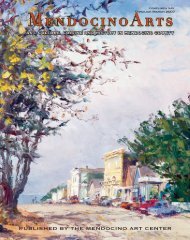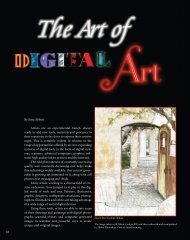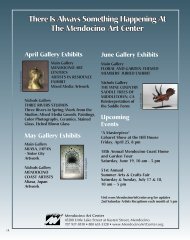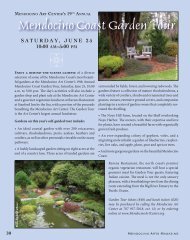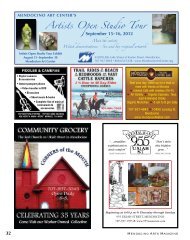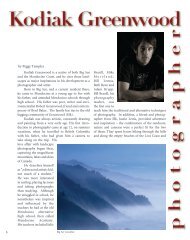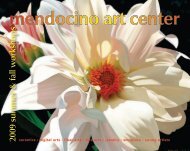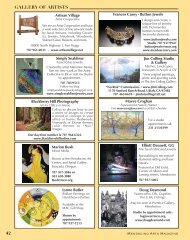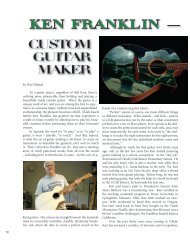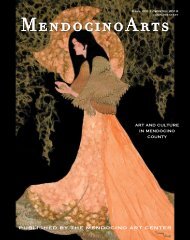There Is Always Something Happening At The Mendocino Art Center
There Is Always Something Happening At The Mendocino Art Center
There Is Always Something Happening At The Mendocino Art Center
Create successful ePaper yourself
Turn your PDF publications into a flip-book with our unique Google optimized e-Paper software.
O r i g i n a l l y ,<br />
baskets were<br />
primarily<br />
utilitarian.<br />
Baskets of<br />
various shapes<br />
and sizes were<br />
used for storage,<br />
cooking<br />
and burden<br />
( i n c l u d i n g<br />
baby) carrying. Highly decorated baskets were used as<br />
gifts or for ceremonies. Miniature baskets might be used<br />
as a form of currency. Beginning in the late 1800’s Pomo<br />
baskets began to be prized by wealthy American and<br />
European collectors. In response to this new demand,<br />
native basket makers began competing with one another<br />
in introducing colorful and intricate designs and decorations.<br />
<strong>The</strong> baskets thus began serving a commercial purpose,<br />
as highly marketable works of art. By the middle<br />
of the 20 th Century, however, the demand for art baskets<br />
had virtually disappeared. Also, by that time, because<br />
Pomo people had embraced – willingly or otherwise – a<br />
more “modern” lifestyle, baskets were no longer particularly<br />
useful. As a consequence, by the time Elsie Allen<br />
began making baskets, in the 1950’s, basket weaving was<br />
in danger of becoming a “lost art.”<br />
After learning to make baskets as a young woman,<br />
and though she continued to “gather” willow and sedge,<br />
and other basket materials, Christine did not do any of<br />
her own weaving for many years while she was raising<br />
her four kids, and, she admits, raising her fair share of<br />
hell. Out of respect for the spiritual aspect of basket<br />
making, she refrained from practicing the art during all<br />
those years. Everything changed, however, when her<br />
son Jonquil was stabbed to death at a “teenage drinking<br />
party,” in February, 1990. To cope with her anger,<br />
and find solace from her grief, she stopped drinking,<br />
and went back to weaving baskets. <strong>At</strong> the same time<br />
Photo by Tom Liden, Photography<br />
she began to dedicate herself to helping Pomo children<br />
appreciate the richness of their cultural heritage, through<br />
instruction in the arts of dance, language, regalia making,<br />
and basketry. For almost twenty years she has worked<br />
regularly as a mentor, in tribal education programs,<br />
through local, state and federal educational programs,<br />
and as a director of Ukiah’s School for the Performing<br />
<strong>Art</strong>s and Cultural Education (SPACE).<br />
In her own words: “I don’t want to leave this earth<br />
having done nothing. Doing baskets helps me bring out<br />
the spirituality that I keep inside me. I do baskets because<br />
I feel chosen. <strong>The</strong>y also let me make a connection with<br />
kids. I teach basket making at Coyote Valley Reservation,<br />
at the public elementary schools, in clean and sober classes<br />
for at-risk kids in high school and junior high, and in<br />
ethnic and teacher training classes at the college. We use<br />
contemporary material – rattan – for twining because it<br />
is easy for people to work with. If Native American kids<br />
look like they are willing and interested, I’ll teach them<br />
to use the traditional materials that we collect and gather<br />
from around the county. What do the students learn?<br />
Keeping their minds and hands working; it’s concentrating<br />
on what your hands are doing – and remembering.”<br />
“My father always said that we have to go along with<br />
the world: ‘<strong>The</strong> world is moving and we have to move<br />
right with it.’ We have to integrate what we believe into<br />
what is happening in the world today. We can’t stay back<br />
in the past. We have to bring it forward. <strong><strong>The</strong>re</strong> will be<br />
changes, but we try to keep certain traditions alive and<br />
abide by them.”<br />
In February, 2004, Christine was honored by the<br />
Women’s History Coalition for her outstanding contributions<br />
to the life and culture of <strong>Mendocino</strong> County.<br />
Christine Hamilton’s handmade baby cradle baskets may<br />
be seen at the Grace Hudson Museum Gift Shop.<br />
25



